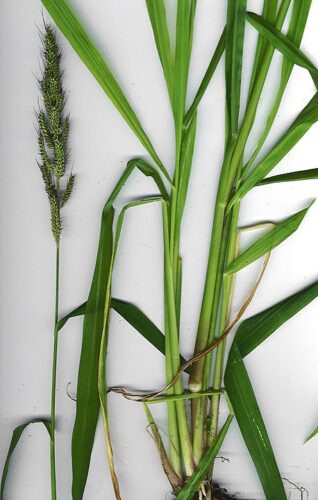Barnyard grass is an annual plant from the grass family.
Also known as:
(Common) Barnyard grass
Cockspur (grass)
Barnyard millet
Water grass
Barnyard grass – Echinochloa crus-galli – is an annual plant in the grass family (Poaceae). Barnyard grass has coarse, broad dark green stems with a white vein in the middle. The base of the stem is reddish purple. After germination, barnyard grass initially grows flat against the ground. Barnyard grass can grow into a large clump of grass over a meter high. The plumes are reddish brown. Barnyard grass is an aggressive grower with a large root system that takes a lot of light, nutrition and water away from surrounding plants.
The seeds of barnyard grass in the soil survive for decades. It germinates as soon as it comes to the surface (digging, newly applied soil). In addition, the seed is dispersed by the wind and via manure: cattle graze in a meadow with barnyard grass, where after the manure contains barnyard grass seed. The seed germinates from the subsequently spread manure (vegetable garden, field).
Habitat
Barnyard grass is found all over the world, except in tropical Africa. In Europe it is common on open, moist reworked nutrient-rich sandy soil along roads, in rough terrain, in cornfields and lawns.
A similar species is Rough barnyard grass (Echinochloa muricata) and, like barnyard grass, it is heat-loving. The Rough barnyard grass is less commonly encountered than barnyard grass. In addition, the Rough barnyard grass has a slight preference for the somewhat moister places.
Control
Barnyard grass is a difficult weed to to control – especially in agriculture, barnyard grass is notorious. In addition it acts as a host for several mosaic virus diseases. In corn fields, barnyard grass competes with maize plants since barnyard grass is insensitive to pesticides used in corn fields.
Regular weeding of germinating barnyard grass prevents this wild grass from developing. Make sure that barnyard grass does not flower and that seed is formed.
Barnyard grass in the lawn is best controlled by exhausting the plant: mow the lawn short (4 cm) and the one-year-old barnyard grass slowly but surely disappears over the course of the season.

